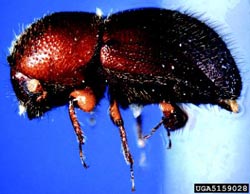How to control maple tree pests using integrated pest management

This is an adult granulate ambrosia beetle, Xylosandrus crassisculus, a pest of maple trees.<br><br>Credit: Photo: J. R. Baker and S. B. Bambara, North Carolina State University, Bugwood.org.<br>
Many maple trees share a suite of important arthropod pests that have the potential to reduce the trees' economic and aesthetic value. Now a new open-access article in the Journal of Integrated Pest Management offers maple tree owners information about the biology, damage, and management for the most important pests of maples with an emphasis on integrated pest management (IPM) tactics for each pest.
In the article, entitled “Biology, Injury, and Management of Maple Tree Pests in Nurseries and Urban Landscapes,” the authors identify 81 potentially damaging arthropod pests and organize them by taxonomic order.
They then review what is known about the life histories, diagnostic features, the types of plant damage they inflict, management practices, and IPM tools for each pest.
Pests include ambrosia beetles, flatheaded appletree borers, maple shoot borers, potato leafhoppers, scale insects, eriophyid mites, and others.
The full article is available to the public for free at http://tinyurl.com/kyk2lez.
The Journal of Integrated Pest Management is an open-access, peer-reviewed, extension journal covering the field of integrated pest management. The intended readership for the journal is any professional who is engaged in any aspect of integrated pest management, including, but not limited to, crop producers, individuals working in crop protection, retailers, manufacturers and suppliers of pest management products, educators, and pest control operators.
The Journal of Integrated Pest Management is published by the Entomological Society of America (ESA), the largest organization in the world serving the professional and scientific needs of entomologists and people in related disciplines. Founded in 1889, ESA today has more than 6,000 members affiliated with educational institutions, health agencies, private industry, and government. Members are students, researchers, teachers, extension service personnel, administrators, marketing representatives, research technicians, consultants, and hobbyists. For more information, please visit http://www.entsoc.org.
Media Contact
More Information:
http://www.entsoc.orgAll latest news from the category: Agricultural and Forestry Science
Newest articles

Properties of new materials for microchips
… can now be measured well. Reseachers of Delft University of Technology demonstrated measuring performance properties of ultrathin silicon membranes. Making ever smaller and more powerful chips requires new ultrathin…

Floating solar’s potential
… to support sustainable development by addressing climate, water, and energy goals holistically. A new study published this week in Nature Energy raises the potential for floating solar photovoltaics (FPV)…

Skyrmions move at record speeds
… a step towards the computing of the future. An international research team led by scientists from the CNRS1 has discovered that the magnetic nanobubbles2 known as skyrmions can be…





















